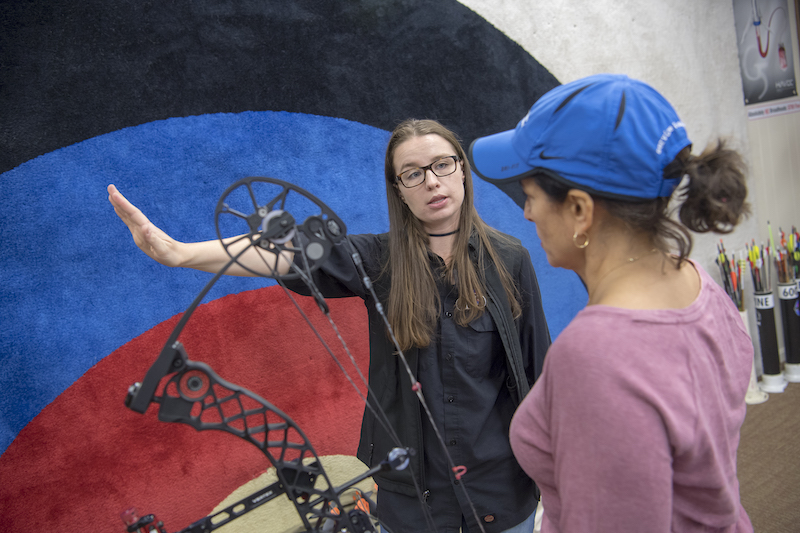You’ve tried archery, you’ve enjoyed it and made a decision.
It’s time to buy a bow.
You’re probably feeling equal amounts of fear and excitement.
Relax.
Take a deep breath.
This is going to be fun. You just need to start the process with an open mind and a positive attitude.
Where to buy?

The most important step in buying your first bow is deciding where to shop. You can buy from a friend, off eBay or from a box store or an archery pro shop. But because this is your first bow, your best bet is an archery store with experienced staff.
You’re most likely to find experts at a pro shop, but some box stores have qualified sales people too. Search Archery 360’s nationwide database of pro shops here.
If you’re unsure what kind of bow to buy – compound, longbow, Olympic recurve or traditional recurve – call some shops to ask what they stock. Visit a shop with a good selection of bows, so you can try them all. You might also consider taking a lesson before buying, so you can try several bow types while learning the intricacies of shooting them all.
Be Prepared
When heading out to buy your bow, dress for action. Baggy clothes and open-toed shoes are poor choices. If you have long hair, tie it back to keep it off your face.
Schedule plenty of time for shopping. You’ll likely need two or three hours to test bows, pick one, set it up, choose arrows, and then shoot the finished rig. If you have only 30 minutes to spare, shuffle your schedule or pick a slower day.
Meanwhile, don’t leave home without a budget. No one has endless amounts of disposable income for the highest quality gear. Besides, most beginners aren’t ready for high-end equipment. Do some homework to learn general prices and options while crafting a budget.
Once you enter the store and explain your intentions, consider the expert’s advice as you fine-tune your spending plan. Keep an open mind as the archery pro offers suggestions. Be prepared to go home empty-handed to save more cash if you discover you’ve overlooked something important.
If you ask for a basic, reliable compound bow for hunting and target shooting the next few years, but you don’t want to spend over $200 you’ll be disappointed.
Ask questions! It’s the sales person’s job to explain every aspect of the buying adventure. That person can’t know what you know or don’t know without your help.
Take Your Best Shot

Before you start test-shooting bows, a bow technician will measure your draw length – that is, how far you should draw back a bowstring. That measurement depends on your height and arm length. The tech will also help you determine how much draw weight you can handle. Your draw weight is the peak amount of force required to pull a bowstring to full draw. That information helps the technician match bows to your size and strength.
Drawing a bow is not a strength test. You should be able to pull the bowstring and hold the bow at full draw with relative ease. That might mean starting with a relatively low draw weight. Drawing a bow requires a unique coordination of muscles in your back, arms and shoulders that you don’t use for routine tasks. It takes time to build that strength and coordination.
Next, the technician will likely take you to the shop’s shooting range. With the technician standing nearby, you’ll shoot several arrows into a target that’s fairly close. The technician will watch your form and aim, while offering advice to correct flaws. As you try various bows and learn what to expect when drawing, aiming and releasing an arrow, your movements will become familiar and smoother.
Necessary Gear
Once you choose a bow, the technician will help you pick some arrows. You’ll likely hear the tech mention arrow “spine,” which means how much the arrow flexes when launched. It should flex some, but not much. Your bow’s correct arrow spine depends on the arrow’s length and your draw weight. Take the technician’s advice on spine.
Now your bow needs accessories, and chief among them is a sight for aiming. You’ll also need an arrow rest to hold the shaft above the shelf; and stabilizer(s), which are rods added to the bow to improve its balance. Depending on which bow you shoot and how you like to shoot, you might benefit from all three accessories, or none of them. The technician can help you decide what’s best for achieving your goals.
If you choose a recurve or longbow, you’ll need a glove or finger tab to protect your fingers from the bowstring as you draw and release it. If you choose a compound bow, you’ll need a release, which is basically a hand-held trigger. Again, the technician will help guide your choice.
Once you’ve chosen your bow, arrows and accessories, the technician will set up everything to produce your customized rig. The technician will then help you sight it in so you can hit your target.
At that point, you’re rigged and ready for a lifetime of fun!




